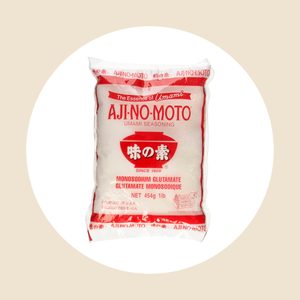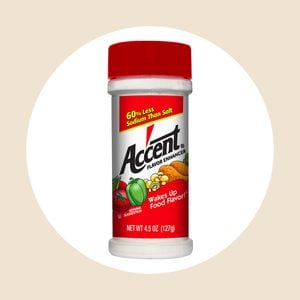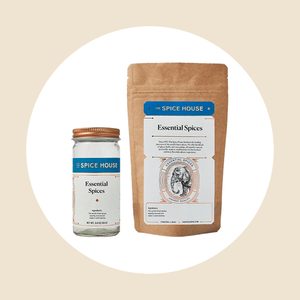What Is MSG? This Is Everything You Need to Know About Monosodium Glutamate
Updated: Feb. 02, 2022

You've heard of MSG (and might even steer clear), but what is MSG and how did it earn such a bad reputation? Here's the truth about this flavor enhancer.
If you’ve ever eaten sauteed mushrooms, fresh tomatoes or Parmesan cheese, then your taste buds have experienced the wonderful taste known as umami. This unique taste is due to the amounts of MSG (monosodium glutamate) present in whatever you’re eating.
What Is MSG?
It’s a common food additive that delivers umami flavor. You can find MSG in plenty of common items: bottled sauces, packaged snacks, a crinkly bag of instant noodles, fast-food items. But MSG isn’t exclusive to processed foods; in fact, tomatoes, walnuts, mushrooms, many cheeses and even human breast milk have concentrations of it.
Who Invented MSG?
Like all magnificent discoveries, the story of MSG has humble beginnings. In 1907, while observing his wife prepare a homemade broth using kelp for yudofu (boiled tofu), Japanese chemist and university professor Kikunae Ikeda became inspired to capture and replicate the distinctly delicious taste of the broth.
After some trial and error, Ikeda discovered that the key to the amazing taste was the amino acid monosodium L- glutamate. Ikeda then patented the process of extracting MSG and began marketing this miraculous seasoning as Ajinomoto—the “quintessence of flavor.” MSG is now a staple ingredient in many Japanese kitchens and Japan hails Ikeda as one of its greatest inventors ever.
What Does MSG Taste Like?
The taste of MSG is hard to describe in full. To some, it’s salty, savory, nutty or even “earthy.” It’s the soothing balance and resounding mmm that you feel whenever your tongue’s taste receptors encounter glutamate. Learn how to create umami flavor when cooking at home.
Is MSG Bad for You?
The short answer: no. MSG is a synthetic form of glutamic acid, an amino acid that’s produced naturally in the human body. There is zero difference between natural glutamic acid and MSG. Your body can’t recognize the difference. Scientific research backs this up. The FDA considers adding MSG to foods to be safe.
Why is MSG controversial if it’s naturally abundant? Why is MSG a health concern even if our bodies can’t distinguish between naturally occurring glutamic acid and the manufactured synthetic variety that is MSG?
Unsurprisingly, much of this scrutiny against MSG over the years has to do with a mixture of racism and misinformation. In 1968, a letter sent to the New England Journal of Medicine by Robert Ho Man Kwok blamed a range of symptoms such as dizziness, headaches and palpitations on the various dishes he ate at a Chinese-American restaurant. Later on, a series of other negative symptoms such as numbness, weakness, swelling and itchiness began being anecdotally reported and grouped together as “Chinese Restaurant Syndrome”.
Over the decades, researchers have conducted numerous studies on “Chinese Restaurant Syndrome” to provide scientific clarity on the topic. Despite anecdotal claims of MSG consumption causing adverse reactions, no study has been able to replicate these issues. At most, only mild short-term symptoms that require no further medical treatment have been recorded when some study participants ate several times the daily serving recommendation of MSG—however, ingesting this much MSG at once is highly unlikely, even if you ate takeout for every meal.
How to Use MSG
MSG is a safe and versatile seasoning—think of it like salt, with the bonus of making the flavors of a dish more dazzling on the palate.
Add MSG to homemade broth for depth of flavor. Sprinkle it atop stir-fries, roasted vegetables, roasted meats or even popcorn for an extra savory burst. Is your homemade sauce or out-of-season produce feeling a little lackluster? Use a dash of MSG.
Unlike salt, MSG makes dishes shine by complementing the flavors already there—try ¼ to ½ teaspoon to start and adjust from there. A little MSG goes a long way, and similar to other seasonings, moderation is key.
Where to Buy MSG
In some places, figuring out where to buy MSG can be difficult because it’s marketed in many ways and with different names. Don’t let that stop you, though! If you’re near an Asian market, look out for the red font on a bag or jar of Ajinomoto. If you’re at your local grocery store, head to the spice aisle near the salt and look for Ac’cent. You can also buy MSG directly from spice and seasoning retailers.
Regardless of where you find MSG, it’s a simple, safe and fun way to add some sparkle to whatever you’re eating.
Peggy Woodward, RDN, Taste of Home Senior Food Editor, contributed to this article.



